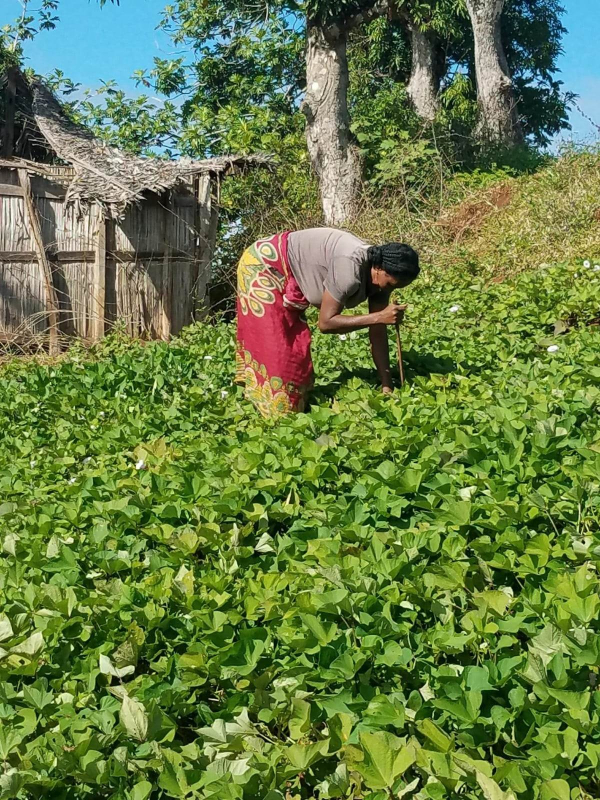Sweetpotato project strengthens communities

Farmer showcasing her virus free sweetpotato field in Kapiri District. Credit - Graybill Munkombwe
African farmers make gains in year two of their sweetpotato project
The sweetpotato project has made some noteworthy contributions to food security, nutrition and biodiversity conservation during its second full year in operation through a successful collaboration with local communities in Madagascar and Zambia.
Funded by the Darwin Initiative, CGIAR and the Crop Trust, the sweetpotato project is led by the Crop Trust with partners including the International Potato Center (CIP), Zambia Agricultural Research Institute (ZARI), and Fiompiana Fambolena Malagasy Norvéziana (FIFAMANOR) in Madagascar.
Sweetpotato is a nutritious staple in Africa, but its diversity is under threat. To safeguard it forever, partners are testing a model that could work not only for sweetpotato but also for other crops that can’t be conserved as seeds.
The best option for conserving sweetpotato diversity for future generations is cryopreservation, which is a process where liquid nitrogen is used to store plant shoot tips at an ultra-low temperature.
The three-year project, which began in June 2022 and is part of the Global Plant Cryopreservation Initiative, employs the 'Clean & Share' conservation approach. This involves collecting, ‘phytosanitary’ cleaning - which removes any diseases or pests from sweetpotato plants - and cryopreserving unique sweetpotato landraces, ensuring their availability for future generations under the FAO International Treaty on Plant Genetic Resources for Food and Agriculture.
Vines collected from landraces in Madagascar and Zambia are initially sent to CIP’s Nairobi facility at the Kenya Plant Health Inspectorate Service, where they are cultured in vitro and cleaned of diseases using heat treatment and by regenerating plants from tiny ‘meristems,’ which are regions of active cell growth, typically found at the tips of roots and shoots.
The disease-free material was then sent back to the national partners in Madagascar and Zambia to be grown out and made available to farmers. The landraces are also sent to CIP’s main genebank in Lima, Peru, for further screening and cryopreservation.
“The long-term conservation of the landraces in CIP genebanks is a guarantee to farmers that these lines can be repatriated to them whenever needed,” says David Ellis, scientist emeritus at CIP.
"The sweetpotato project has made some noteworthy contributions to food security, nutrition and biodiversity conservation during its second full year in operation through a successful collaboration with local communities in Madagascar and Zambia."
Community inclusion
The sweetpotato project has engaged local communities from the planning stage through to implementation, addressing challenges that include poor yields due to plant viruses; child malnutrition; and natural phenomena such as cyclones and drought.
Another hurdle is farmers’ reluctance to ‘give up’ their landraces, which they have nurtured and protected for generations. Often, the concept of long-term conservation in a distant land is new and strange. Therefore, the project has been careful to explain the project’s goals to ensure that prior informed consent is obtained.
Gender equity is a special focus of the project, which has seen women account for 63% of the participating farmers in Zambia and 50% of the implementing officers there. In Madagascar, the selection of technicians and farmers collecting landraces involved men and women in equal measure, while married couples would alternate their attendance at training sessions whenever possible.
Zambia
In Zambia, the project has focused on the four districts of Choma, Monze, Masaiti and Kapiri Mposhi. The communities selected as beneficiaries are sweetpotato growers who have, over time, lost the genetic diversity of sweetpotato cultivars to the ravages of climate change.
Community leaders helped the Department of Agriculture identify project sites and participating farmers, who attended meetings to design, implement and monitor activities. They also received training on field layout, crop management and plant disease prevention.
As a result, the project was able to distribute 46,200 vines of 16 landraces to 60 farmers in the chosen districts. This is helping improve crop harvests, enhance food security, raise household incomes and therefore reduce poverty levels.
“Restoring the genetic diversity of these landraces leads to incremental areas under sweetpotato cultivation each growing season,” says Graybill Munkombwe, principal agriculture research officer at the National Plant Genetic Resources Centre, ZARI. “This will ultimately improve the wellbeing of the target communities significantly.”
Madagascar
In Madagascar, the Indigenous Malagasy people are particularly vulnerable to food insecurity caused by drought and cyclones. The Central Highlands region, called Vakinankaratra, is prone to frost, inhibiting the growth of sweetpotato and contributing to a malnutrition rate of 51% in children under 2 years of age.
To counter this reality, farmers helped identify diverse landraces for collection in 5 regions of the country and later participated in the vine multiplication process, enabling the project to increase the number of vines distributed to 25 farmers.
Over the past year, the project has been able to multiply 10,000 vines of 22 local landraces in Madagascar and to boost farmers’ interest in planting sweetpotato.
“The cleaning of the sweetpotato landraces from viral diseases, and the sharing of the purified vines with the population, will enhance the productivity of sweetpotato farmers and help fight food insecurity,” says Noroseheno Ralisoa, the project’s principal partner from FIFAMANOR.

Anyone, anywhere
A vast amount of sweetpotato diversity important to smallholder farmers in both Madagascar and Zambia has now been collected, 75 landraces from Madagascar and 260 from Zambia, and placed into secure long-term conservation. Once confirmed to be phytosanitary clean in CIP-Lima, anyone in the world can request this material for use in research, breeding or training.
“The project’s second-year results are testament to the power of collaboration between multiple partners located in four countries,” says Sarada Krishnan, director of programmes at the Crop Trust. “In spite of the challenges, sweetpotato farmers in Madagascar and Zambia today are better placed to deliver food security and boost their own livelihoods than they were a year ago.”
The sweetpotato project is scheduled to end on 31 March 2025.
Written by David Henry. For more information on this Darwin Initiative Main project 29-025, led by Global Crop Diversity Trust (Crop Trust), please click here.

 Back
Back